De aanpak van FutureWater en Galayr is zowel wetenschappelijk rigoureus als contextueel onderbouwd, zodat het ontwikkelde droogtemodel lokaal relevant, duurzaam en volledig geïntegreerd is in bestaande nationale systemen zoals die van SODMA en NADFOR. In het model worden top-down (gegevensgestuurd, met behulp van machinaal leren) en bottom-up (op basis van informatie van belanghebbenden) benaderingen gecombineerd, waarbij satellietgegevens, klimaatindices en inheemse kennis worden gecombineerd om gezamenlijk op impact gebaseerde voorspellingen en op consensus gebaseerde triggers voor anticiperende actie te ontwikkelen.
Voor de ontwikkeling van het droogtevoorspellingsmodel en de kennisoverdracht richten we ons op de volgende pijlers:
- Een gefaseerd werkplan dat institutionele capaciteitsbeoordelingen, modelontwikkeling, validatie, overleg met belanghebbenden en praktische capaciteitsopbouw omvat.
- Toepassing van geavanceerde voorspellingsmodellen, variërend van ARIMA en regressie tot meer geavanceerde machine learning-technieken, met behoud van de focus op bruikbaarheid en institutionele adoptie.
- Een sterke nadruk op kennisoverdracht, inclusief trainingsprogramma’s en het opzetten van een gezamenlijk platform voor het delen van kennis met behulp van het FutureWater Academy-platform
- Een robuust risicomanagementplan, inclusief mitigatiestrategieën voor dataschaarste, betrokkenheid van belanghebbenden en institutioneel verloop.



